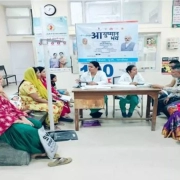Liberal Transfusion Strategy in MI with anaemia: No benefits found

Liberal Transfusion Strategy fails to reduce risk of recurrence and death in MI patients with anemia suggests a new study published in The New England Journal of Medicine.
A strategy of administering a transfusion only when the hemoglobin level falls below 7 or 8 g per deciliter has been widely adopted. However, patients with acute myocardial infarction may benefit from a higher hemoglobin level. In this phase 3, interventional trial, we randomly assigned patients with myocardial infarction and a hemoglobin level of less than 10 g per deciliter to a restrictive transfusion strategy (hemoglobin cutoff for transfusion, 7 or 8 g per deciliter) or a liberal transfusion strategy (hemoglobin cutoff, <10 g per deciliter). The primary outcome was a composite of myocardial infarction or death at 30 days. RESULTS:A total of 3504 patients were included in the primary analysis. The mean (±SD) number of red-cell units that were transfused was 0.7±1.6 in the restrictive-strategy group and 2.5±2.3 in the liberal-strategy group. The mean hemoglobin level was 1.3 to 1.6 g per deciliter lower in the restrictive-strategy group than in the liberal-strategy group on days 1 to 3 after randomization. A primary-outcome event occurred in 295 of 1749 patients (16.9%) in the restrictive-strategy group and in 255 of 1755 patients (14.5%) in the liberal-strategy group Death occurred in 9.9% of the patients with the restrictive strategyand in 8.3% of the patients with the liberal strategy. In patients with acute myocardial infarction and anemia, a liberal transfusion strategy did not significantly reduce the risk of recurrent myocardial infarction or death at 30 days. However, potential harms of a restrictive transfusion strategy cannot be excluded
Jeffrey L. Carson, Maria Mori Brooks, Paul C. Hébert, Shaun G. Goodman, Marnie Bertolet, Simone A. Glynn, Bernard R. Chaitman, Tabassome Simon, Renato D. Lopes, Andrew M. Goldsweig, Andrew P. DeFilippis, J. Dawn Abbott. Restrictive or Liberal Transfusion Strategy in Myocardial Infarction and Anemia. N Engl J Med 2023; 389:2446-2456. DOI: 10.1056/NEJMoa2307983
Keywords:
Liberal, Transfusion, Strategy, fails, reduce, risk, recurrence, death, MI patients, anemia, The New England Journal of Medicine, Jeffrey L. Carson, Maria Mori Brooks, Paul C. Hébert, Shaun G. Goodman, Marnie Bertolet, Simone A. Glynn, Bernard R. Chaitman, Tabassome Simon, Renato D. Lopes, Andrew M. Goldsweig, Andrew P. DeFilippis, J. Dawn Abbott
Powered by WPeMatico





















